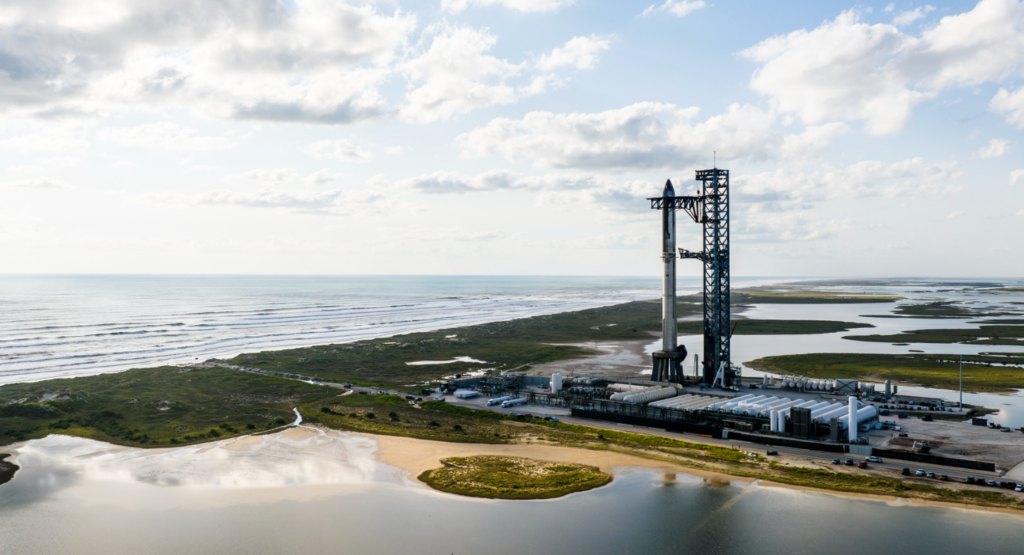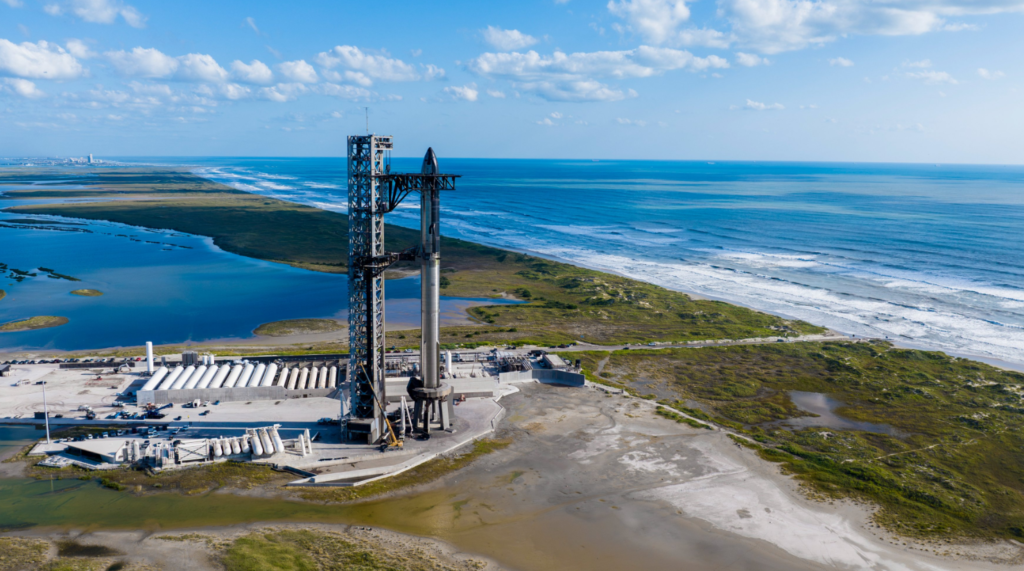After 128 days of prep, testing, and work both on the vehicle and Stage 0 infrastructure, SpaceX is officially ready to launch Starship Flight 5 tomorrow morning. Just hours ago they announced that the FAA approved the flight with SpaceX receiving an official launch license.
With everything now in place, teams are getting ready to not only launch the vehicle tomorrow but also attempt to catch the booster out of mid-air.
FAA Approval

Earlier today the FAA approved the launch license for IFT-5. The official document is quoted saying, “Space Exploration Technologies Corp is authorized, subject to the provisions of 51 U.S.C. Subtitle V, chapter 509, and the orders, rules, and regulations issued under it, to conduct launches of the Starship-Super Heavy vehicle. Below that it highlights the issued and effective date of October 12th, 2024. This means as of right now SpaceX is cleared to launch the Starship vehicle.
SpaceX even tweeted right after confirming, “Targeting Sunday, October 13 for Starship’s fifth flight test. A 30-minute launch window opens at 7:00 a.m. CT.”
In addition, we also got an idea of how the license was expedited and managed to come today rather than late November, as the FAA had been saying. Specifically, in a document from the Fish And Wildlife Service, they are quoted saying, “The FAA requested the Service separately consider new information provided by SpaceX, including updated sonic boom overpressure contours from sonic boom monitoring data collected during the landing of the Super Heavy booster in the Gulf of Mexico during Flight 4, and provide an expedited response solely for the purposed Flight 5, prior to the conclusion of the reinitiated section 7 consultation for the larger program.
With all this in mind, as mentioned in the tweet, the launch window is set to open at 7:00 a.m. CT. That being said SpaceX points out that because this is developmental testing, the schedule is dynamic and likely to change, so there could be updates to that time the morning of. Looking at some of the last few Starship launches, there is some leeway in when exactly it takes off.
As far as how to watch, the official SpaceX webcast is set to go live about 30 minutes before the launch window opens on X. Well before that SpaceX will begin some of the pre-launch activities early in the morning. Looking at the flight profile, 1:15:00 before launch the SpaceX Flight Director will poll and verify GO for propellant load. Around T – 50:00, both Ship fuel (liquid methane) and Ship LOX (liquid oxygen) will begin filling the stage. 10 minutes later at T – 40:40, methane will begin filling the booster and not long after liquid oxygen as well.
By the time the livestream begins the rocket should already have begun fueling and general propellant load for both of the stages. At T – 19:40, the Raptors begin engine chill on the booster and ship. Over the next 15 minutes, the two stages continue to fill with propellant until T – 3:20, at that point the upper stage is full. Only 30 seconds later the booster will also complete its propellant load.
At this point, assuming everything looks good on SpaceX’s side, at T – 00:30, the SpaceX flight director verifies GO for launch. With 10 seconds left the water deluge system begins spraying tons of water in preparation for ignition. The Raptors ignite, and soon after the clock hits zero we can expect the liftoff of Starship.
We then will see a launch similar to Flight 4 with the exception of the booster which will attempt a catch back at the launch site. It’s important to point out that the default mission has the booster splashing down in the Gulf of Mexico. Only if thousands of distinct vehicle and pad criteria are met, along with the manual command sent from the Flight Director, will the booster return to the launch site for a catch. In other words, if everything looks perfect a few minutes into the launch, we can expect a booster catch attempt. If it does end up happening, the catch and engine shutdown is set to occur at T + 6:56.
As for the upper stage, SpaceX was quoted saying, “Starship will fly a similar trajectory as the previous flight test with splashdown targeted in the Indian Ocean. This flight path does not require a deorbit burn for reentry, maximizing public safety while still providing the opportunity to meet our primary objective of a controlled reentry and soft water landing of Starship.
Sonic Booms

Interestingly, one of the areas that was set to delay this launch until November, and was mentioned in the earlier document from the Fish and Wildlife Service, had to do with sonic booms, now that the booster is returning to the launch site.
To put in perspective the importance of this event to certain groups, SpaceX over the last few months has made multiple statements related specifically to sonic booms. In July for example, they released an entire statement specifically on sonic booms.
Here they clarified, “A sonic boom is a brief, thunder-like noise a person on the ground hears when an aircraft or other object travels faster than the speed of sound. As a fast-moving object travels through the air, it pushes the air aside and creates a wave of pressure which eventually reaches the ground. The change in air pressure associated with a sonic boom, known as overpressure, increases only a few pounds per square foot. A person could experience a similar pressure change by riding down several floors in an elevator. What makes sonic booms audible is the quick speeds at which the pressure change occurs.”
“Generally, the only impact to those in the surrounding area of a sonic boom is the brief noise. There are many variables that determine the impact of sonic booms, including the mass, shape and size of the object traveling at high speeds, along with its altitude and flight path. External factors like weather conditions can also affect the intensity of a sonic boom. The strongest effects of the sonic boom’s pressure change are localized to the area directly beneath the vehicle, concentrated under the rocket’s flight path and the landing site.”
They then said, “Data gathered from the first ever Super Heavy landing burn and splashdown on Starship’s fourth flight test indicates that while Super Heavy’s sonic boom will be more powerful than those generated by Falcon landings, it does not pose any risk of injury to those in the surrounding areas. The strongest effects will be localized to the area immediately around the Starbase launch pad. This area is cleared well in advance of launch and has been rigorously designed to withstand the environments of launching and returning the most powerful rocket ever flown” they said.
Even more recently in a separate statement, the company said, “The FAA, in consultation with the U.S. Fish and Wildlife Service, evaluated sonic booms from the landing of the Super Heavy and found no significant impacts to the environment. Although animals exposed to the sonic booms may be briefly startled, numerous prior studies have shown sonic booms of varying intensity have no detrimental effect on wildlife. Despite this documented evidence, the FAA leadership approved an additional 60-day consultation with U.S. Fish and Wildlife as a slightly larger area could experience a sonic boom” they said.
Based on the document, it seems this specific process was sped up to allow a launch license at least for Flight 5. However, based on the wording it suggests that those agencies still want to gather more data on the sonic booms and their impacts.
On the bright side, it’s possible that tomorrow morning we actually hear it for ourselves as the booster attempts a catch back at the launch site. In regard to this process, there definitely is some risk involved. The booster will be coming in fast and will need an extremely precise landing in addition to the proper function from the catch arms.
That being said, at this point in the mission the booster will have very little propellant left which in the event that something goes wrong, will help avoid a massive explosion. There also is a second tower constructed which means damage to one is not the end of the world.
Despite all the challenges and risks, SpaceX seems confident. A few days ago the SpaceX Vice President was quoted saying, “We landed with half a centimeter (0.2 in) accuracy in the ocean, so we think we have a reasonable chance to go back to the tower.”
On the last launch, we saw the booster make its way down toward the water and even with an engine going out during the process, still managed to make a controlled splashdown. Since then there have been upgrades to this system among others helping improve its odds.
SpaceX was quoted saying, “Extensive upgrades ahead of this flight test have been made to hardware and software across Super Heavy, Starship, and the launch and catch tower infrastructure at Starbase. SpaceX engineers have spent years preparing and months testing for the booster catch attempt, with technicians pouring tens of thousands of hours into building the infrastructure to maximize our chances for success. We accept no compromises when it comes to ensuring the safety of the public and our team, and the return will only be attempted if conditions are right.
Conclusion
SpaceX is now less than 24 hours away from Starship Flight 5. They just got approval from the FAA and now are ready for possibly the first catch attempt of the booster. Early tomorrow morning the company’s official Livestream will begin and we’ll get a good idea of any small delays or changes depending on what happens.
